Marshmallow Peeps have an amazing cult following, and it’s no wonder why: they are cute, abstract, colorful, ubiquitous, and sugary. While it sometimes seems that the entire human race is firmly in favor of performing cruel experiments on them, there is a little less consensus on whether or not one should actually eat them. Both sides of the aisle have their merits, of course, and more often than not the debate is merely over whether fresh or stale peeps are tastier. All debating aside, here’s a gourmet option for fans of Peeps that prefer to stuff their gizzards with something other than mass-produced marshmallows: Saffron Meringue Chicks!
Much has been written on peeps. An excellent place to start is this article from 2000 on peeps etiquette, which states that “there are, believe it or not, 20 Web sites devoted to Peeps, and many feature crafty projects.” While we’re not quite sure how to adjust that figure of 20 sites for internet inflation, a recent Google search for “marshmallow peeps” turns up more than 160,000 hits. Obviously we haven’t been to all of them, but here are some highlights from the pages that we have seen:
- Peeps prank
- Peeps Jousting
- Peep research
- Peep electrocution
- Official peeps site
- The Big List Of Peeps Links
- Tracy & Mia’s Peep-O-Rama
- Peeps cluster on flickr, where you can find peep sushi, peeps treated like lobsters, peeps going for a ride, peep fashion, and peep cannibalism
- A marshmallow chick recipe and video from the Culinary Institute of America.
Most pertinent to our project (via not martha) is this article about DIY peeping, including the official but 2-D Peep kit, how to make your own in 3D, and marshmallow recipes from Brownie Points.
While fresh marshmallows are fantastic, meringue gives you the option of omitting the gelatin (a plus for semi-vegetarians such as ourselves) and not worrying about getting to the “soft-ball stage” in candy making. Meringues are pretty straightforward: whip stuff together and then bake at a low temperature for a long time. Ours have the added bonus of a natural coloring agent (saffron) which produces the perfect peep yellow and imparts a very distinctive flavor.
Start out with a basic meringue recipe like this one (we used the meringue cookie recipe from Baking Illustrated) and mix 1/4 to 1/2 teaspoon crumbled saffron strands into the egg whites prior to whipping them.
Spoon the meringue cream into a pastry bag or gallon ziplock bag fitted with an icing tip.
Put some parchment paper on a cookie sheet so that your meringues won’t stick.
Pipe the chicks starting with the body, back up for the neck, then release pressure and pull away for the beak.
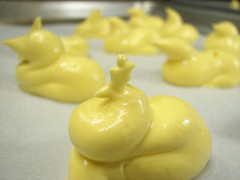 Mutant peeps can be sculpted with a toothpick. (This one looks more like an (obese) adult chicken than a chick.)
Mutant peeps can be sculpted with a toothpick. (This one looks more like an (obese) adult chicken than a chick.)
Optionally, sprinkle with a thin even layer of granulated sugar before baking.
The sugar gives your baked meringue the illusion of being an encrusted marshmallow– the yellow meringue encrusted with clear sugar looks just like the white marshmallow encrusted with yellow sugar. Don’t overdo it on the sugar sprinkles– it can weight down the meringue during baking, and excessive sweetness does not compliment the saffron.
Bake according to your recipe, usually one to two hours in a barely warm oven. Once they are out and cool, it’s time to add the eyes.
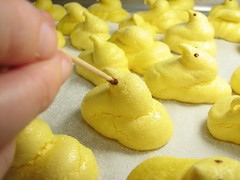 Melt a few chocolate chips and dab eyes on. The tool shown here is a Japanese-style toothpick. The flat end is just the right size for the job. If your sugar layer is particularly heavy, you’ll need a larger dab of chocolate. For smoother peeps, you need hardly any at all.
Melt a few chocolate chips and dab eyes on. The tool shown here is a Japanese-style toothpick. The flat end is just the right size for the job. If your sugar layer is particularly heavy, you’ll need a larger dab of chocolate. For smoother peeps, you need hardly any at all.
Admire your finished saffron meringue chick.
Next thing you know, armies of little yellow pseudo-peeps will be coming to rule the world. Save room for dessert.




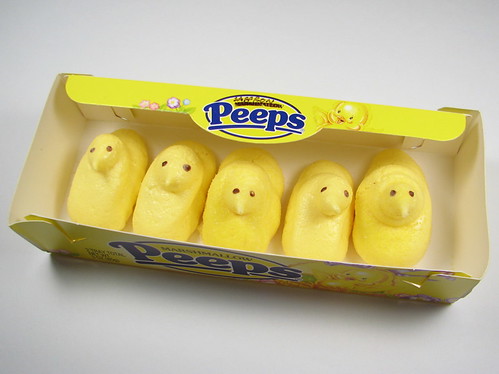
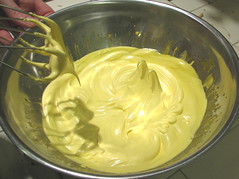
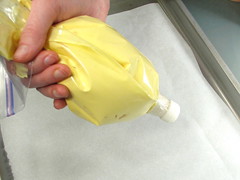
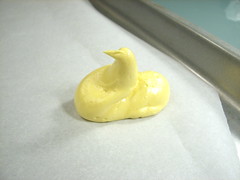
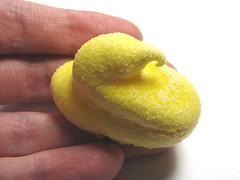
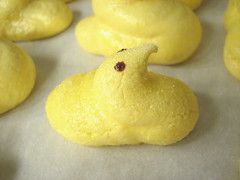
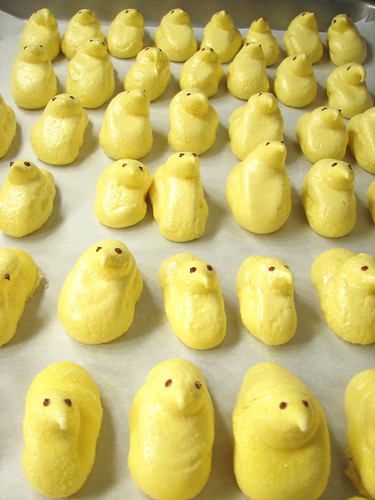
Hmm. How do you think meringue would work in a 3D printer? Think you could cook/dry it in the printer environment without cooking the unprinted meringue as well?
Meringue cream is thick and gooey, and working precisely with it is a challenge. Once you are past that technical difficulty, it does need to be cooked, so you would either need an oven integrated in the design of your printer or a way to move the model from the printer to the oven.
A heater integrated into the printing head would be ideal– you could make arbitrarily complicated tasty sculptures that way. The down side is that meringues are cooked at low heat over a very long period of time to dry out, so it’s hard to imagine how long it would take to dry every 3D pixel (voxel) one at a time.
On the other hand, if the wall thickness were kept low everywhere, you could move the whole thing to the oven, as suggested. We might have to try it.
—
Windell H. Oskay
drwho(at)evilmadscientist.com
http://www.evilmadscientist.com/
I got so excited when you started talking about no gelatin… but was crushed by the inclusion of eggs.
None the less, it seems like a fun project thank you for sharing, I’m sure lots of people will have fun with this one – Thank you!
Since Meringues are essentially whipped and cooked egg whites, it’s hard to imagine any successful substitution!
On the other hand, if vegan cooking is your goal, you might want to go right back to the marshmallow-based recipe– substituting vegan gelatin.
—
Windell H. Oskay
drwho(at)evilmadscientist.com
http://www.evilmadscientist.com/
Thats for the tip, Pangea isnt too far from me actually.
I might just swing by and try my hand at some vegan chickies!
Here’s another (mis)use for Peeps:
http://bikerpeeps.com/
Being a motorcyclist, it makes me laugh anyway.
charles
Do you need to add vanilla or is the saffron enough?The recipe said to add it at a certain point, if using.
Saffron on its own is a very strong flavor, and you do need not *need* to add any other flavors, but you certainly can add vanilla if you wish– it won’t hurt.
—
Windell H. Oskay
drwho(at)evilmadscientist.com
http://www.evilmadscientist.com/